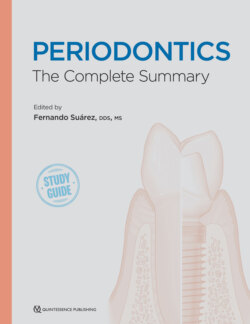Читать книгу Periodontics - Fernando Suarez - Страница 66
На сайте Литреса книга снята с продажи.
Treatment outcomes
ОглавлениеIn the classic longitudinal studies performed at the University of Nebraska, periodontal patients were enrolled in a maintenance program and followed up for 6 years after receiving active treatment. Smokers demonstrated poorer response to surgical and nonsurgical treatment, having lower probing depth (PD) reduction and clinical attachment level (CAL) gain.19 When furcation sites were analyzed separately, smokers had 0.5 mm less CAL gain and 0.6 mm less PD reduction compared with nonsmokers.19 A noteworthy observation from a different publication by the same group is that smokers exhibited a similar percentage of sites with BOP as nonsmokers.20 Other studies reported smokers having higher percentages of sites with BOP than nonsmokers with similar levels of oral hygiene.21 The inferior response of smokers to nonsurgical periodontal treatment is also observed in cases where local delivery of antibiotics is used as an adjunct to scaling and root planing.22
As mentioned previously, smoking negatively affects the response to surgical as well as nonsurgical periodontal treatment.19,22,23 Guided tissue regeneration is negatively affected as well. Clinical studies performed in private practices in Italy concluded that smokers had approximately 3 mm less CAL gain 12 months postoperatively (2.1 ± 1.2 mm) compared with nonsmokers (5.2 ± 1.9 mm).24 When followed up for an extended period of 5 years, stable treatment outcomes were associated with patients who were not smokers, who maintained adequate oral hygiene, and who complied with supportive periodontal treatment.25 Similarly, soft tissue grafting procedures are negatively influenced by smoking habits.26
It should be noted that despite the fact that the treatment response following smoking cessation is comparable with nonsmokers, this does not reverse the detrimental effects of smoking that have already manifested.21,27 Tomar and Asma28 analyzed the data from the Third National Health and Nutrition Examination Survey (NHANES III). The sample consisted of more than 13,000 adults, and it was estimated that it is four times more likely for current smokers to have periodontitis compared with individuals who never smoked. When former smokers were analyzed separately, the ones who had quit smoking in the previous 2 years were more likely to be diagnosed with periodontitis, and this likelihood decreased gradually. Former smokers who quit smoking for at least 11 years were as likely to have periodontitis as those who had never smoked. According to this study, almost three-fourths of periodontitis cases in the United States (74.8%) are attributed to smoking.28
Ultimately, smoking increases the likelihood of tooth loss. McGuire and Nunn29 discussed the prognosis and prediction of tooth loss and followed up with periodontal maintenance patients for 14 years. They estimated the risk for tooth loss to be increased by 2.9 times for heavy smokers (Box 4-2).
BOX 4-2 Link between smoking and periodontal status
GTR, guided tissue regeneration; SRP, scaling and root planing.
